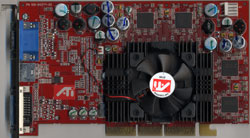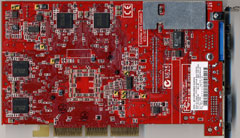
Original Link: https://www.anandtech.com/show/970
ATI Radeon 9700 Pro - Delivering as Promised
by Anand Lal Shimpi on August 19, 2002 8:00 AM EST- Posted in
- GPUs
Just over a month ago we brought you a preview of ATI's most impressive GPU to date - the R300. Although ATI had previously given us every reason to be skeptical of their ability to beat NVIDIA, the R300 removed all doubt from our minds. The chip was very NVIDIA-like in design, employing an architecture very similar to NV30. Gone were the days when ATI would bank on features like a radical 3rd texture unit per pipeline; the R300 was designed with tried and true philosophies and unlike most of NVIDIA's competitors, ATI seemed to have learned from their mistakes.
Our only remaining worry was that ATI would not be able to deliver the very large and very expensive R300 chip as promised. ATI made us a promise that they would begin shipping to retail in roughly a month from the R300's technology announcement; if you do a quick search you'll see that ATI even delivered on this promise as well. Just as ATI announced a couple of weeks ago, retail shipments of the Radeon 9700 Pro have commenced as of today (8/19/2002).
With the chip and the card on time, the only thing that remained was a confirmation of clock speeds. One of the biggest concerns that exists when dealing with a large chip like the R300 is the issue of binning. It all boils down to one very simple principle; the higher the clock speed, the lower the yield will be and there was a lot of doubt that ATI could reach core clocks over 300MHz. Part of the secret to ATI's ability to launch the R300 at 325MHz is contained within the Radeon 9700 Pro name, but we'll get to that later.
As the Radeon 9700 Pro begins its journey into the hands of the fortunate few that are spending $399 on a video card, we're here to bring you a final review of the card based on shipping hardware.
If you haven't already, be sure to read our technology overview and performance preview of the Radeon 9700 Pro since we'll be assuming that you're already familiar with the R300's architecture at this point.
What's in a name - Radeon 9700 Pro
When ATI announced that the first shipping R300 boards would be called the Radeon 9700 Pro, we immediately asked if there would be a regular Radeon 9700. Although ATI won't be producing a Radeon 9700 board themselves, their partners will be selling lower clocked R300 boards and calling them Radeon 9700s. An official clock speed hasn't been set on the non-Pro parts but we'd anticipate something closer to the 300/300MHz mark.

By going with this dual tiered approach, ATI can ensure that their $399 Radeon 9700 Pro cards offer the same speed that they originally promised in July while at the same time delivering lower priced and higher yield parts for their board partners.
Prices haven't been set on non-Pro Radeon 9700s at this point, but with Pro street prices hovering around the $380 mark we'd expect to see a $350 pricepoint for the regular Radeon 9700. A regular Radeon 9700 would be an interesting competitor to the GeForce4 Ti 4600 as it could offer somewhat higher performance at a much more competitive price to the now sub-$300 Ti 4600.
ATI already announced that the Radeon 9700 Pro would run at a core clock of 325MHz with 310MHz DDR memory (effectively 620MHz). If you remember back to our original piece on the R300, these are the exact same clock speeds we tested with.
The Card
The final Radeon 9700 Pro card hasn't changed noticeably from the pre-release board we tested last month. The red PCB remains although the fan is much less GeForce4-like.
You can see a small heatspreader on the back of card to help dissipate heat away from some of the power circuitry.
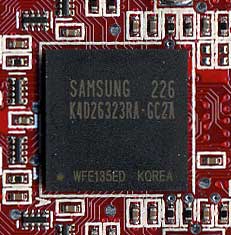
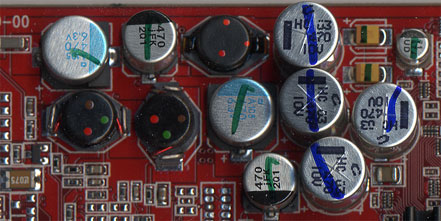 |
 |
ATI still hasn't announced a dual-DVI version of the Radeon 9700 Pro, which is still disappointing considering the high pricetag of the part. If you do want dual DVI outputs and the R300 GPU then you will have to wait for the professional version of the card under the FireGL brand (FireGL X1).
The Drivers
ATI supplied us with WHQL certified drivers that the Radeon 9700 Pro is currently shipping with based off of the CATALYST 2.2 platform. The drivers look and feel just like the other CATALYST releases with two changes that are R300-specific.
First, the quality/performance antialiasing settings are gone because of the R300's support for multisampling AA. You can choose 2X, 4X or 6X multisampled AA modes from the control panel.
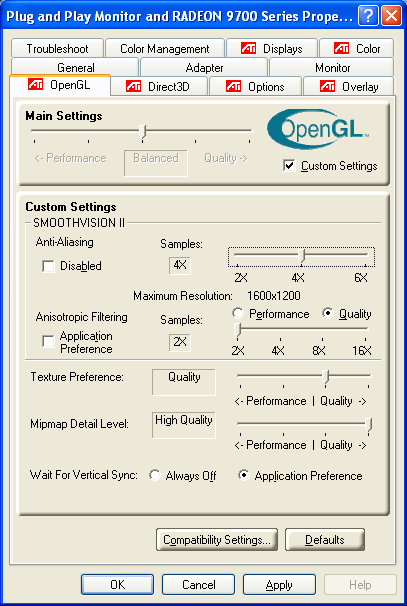
The only other change is the inclusion of performance/quality radio buttons for anisotropic filtering. The performance mode appears to be identical to the anisotropic filtering on the Radeon 8500 (except with Trilinear support), while the quality mode properly handles situations where there is rotation along the z-axis.
We did not run into any major issues with the Radeon 9700 Pro's drivers although a few minor bugs did crop up. The most irritating was that we had to reboot our testbed after switching antialiasing or anisotropic filtering modes between Unreal Tournament 2003 benchmarks otherwise the new settings would not take effect.
The Test
As we've already shown, the Radeon 9700 Pro is noticeably faster than anything else that's currently available; thus we limited our comparison to the GeForce4 Ti 4600 alone.
Because of its close proximity in price, we wanted to include the Matrox Parhelia however with the latest build of UT2003 and the latest Parhelia drivers we could not get our benchmarks to complete. Seeing as how the majority of our benchmark suite depends on UT2003, we had to exclude the Parhelia from this comparison.
|
Windows
XP Professional Test Bed
|
|
|
Hardware
Configuration
|
|
| CPU |
Intel
Pentium 4 2.53GHz
133.3MHz x 19.0 |
| Motherboard |
Intel
D850EMV2
Intel 850E Chipset |
| RAM |
4
x 128MB PC1066 Kingston RIMMs
|
| Sound |
None
|
| Hard Drive |
80GB
Maxtor D740X
|
| Video Cards (Drivers) |
ATI Radeon 9700
(128MB) - CATALYST 2.2 |
Unreal Tournament 2003
Epic provided us with a new build of the UT2003 engine with a few more levels back when we were doing our testing on Trident's XP4. It is that same build of the engine that we're using here for our Radeon 9700 Pro benchmarks. You'll notice that there are quite a few more levels in this benchmark, one of which is even more intense than the previous king - antalus.
|
|
|
For starters, the Radeon 9700 Pro holds a 30 - 70% advantage over the GeForce4 Ti 4600 depending on resolution.
|
|
|
The asbestos benchmark has always been more CPU bound, which is why the Ti 4600 is able to come within 6% of the Radeon 9700 Pro at 1024x768. The largest performance difference here is just under 40% at 1600x1200.
Unreal Tournament 2003 (continued)
We continue our UT2003 testing with a CTF benchmark and a benchmark of the new bombing run gameplay mode.
|
|
|
The two contenders are virtually tied at 1024x768, which is an indication of very solid drivers on NVIDIA's part. The Radeon 9700 Pro manages to extend a 33% lead at 1600x1200 where its memory bandwidth helps tremendously.
|
|
|
With frame rates as high as 173 fps at 1024x768, it's no wonder that the Radeon 9700 can't stretch its wings until we crank up the resolution to around 1600x1200. Even then, the card scores over 110 fps and 43% faster than the Ti 4600.
Unreal Tournament 2003 (continued)
For our final set of UT2003 numbers we have another deathmatch benchmark and a benchmark from one of the game's double domination levels:
|
|
|
Inferno, as you can see, is even more stressful than antalus; the Radeon 9700 Pro does not disappoint as it manages to hold a 50 - 60% performance lead over the Ti 4600.
|
|
|
Our final UT2003 benchmark continues the relative trend we've seen, with a 24 - 59% performance advantage for the Radeon 9700 Pro depending on resolution.
Comanche 4
Flight simulators rarely make good graphics benchmarks as they are mostly CPU/platform limited, but in order to make this review complete with included one in the test suite. We used the publicly available Comanche 4 demo and ran its internal benchmark to see if it could harness the power of the R300:
|
This should come as a bit of a surprise, but the Radeon 9700 Pro actually falls behind the Ti 4600 in this test. The explanation is simple; at most resolutions Comanche 4, like most flight simulators, is CPU and driver bound allowing the lesser equipped GeForce4 to inch its way ahead.
|
The two are effectively tied at 1280x1024.
|
Finally at 1600x1200 we begin to see the Radeon 9700 Pro pull away, but not by much; it's clear that both of these cards are overkill for this game.
Jedi Knight 2
Based on the Quake III engine, Jedi Knight 2 is another heavily CPU bound gaming benchmark that we've thrown into the suite; after seeing the Comanche results you should generally know what to expect here.
|
Once again we see the Radeon 9700 Pro fall behind as driver efficiencies give the GeForce4 Ti 4600 the slight lead.
|
ATI isn't quite able to turn the tables just yet...
|
Finally at 1600x1200, the extra memory bandwidth of the Radeon 9700 Pro comes in handy and gives the card a 12% performance advantage.
Serious Sam 2
|
|
|
Codecreatures DirectX 8.1 Benchmark
Codecult's Codecreatures engine has been turned into a fairly interesting DirectX 8.1 benchmark. Without widespread use of the engine this test ends up being no better than a synthetic benchmark, but it's interesting to see the results to help get an idea for how these cards perform under intense DirectX 8.1 applications.
|
|
|
The Radeon 9700 Pro holds about a 30% advantage over the Ti 4600 across the board.
Memory Controller & Synthetic Performance Tests
ATI was the first to introduce significant occlusion culling technology for the early rejection of pixels that won't be seen by the user before they are rendered. In order to test this we dusted off Villagemark, a benchmark with an incredible amount of occluded pixels that shouldn't be rendered if your GPU is smart enough to realize that.
|
A number of factors contribute to the Radeon 9700 Pro's 47% performance advantage here, but a good chunk of the performance improvement does come from HyperZ III. NVIDIA will have their chance to answer with NV30 later this year.
For synthetic performance we chose 3DMark 2001SE with the latest 330 patch applied. We don't put much weight on the 3DMark tests but we can get some useful information out of them:
|
3DMark
Score @ 1024x768
|
Multitextured
Fill rate (MTexels/s)
|
High
Polygon Count - 1 Lights (MTriangles/s)
|
High
Polygon Count - 8 Lights (MTriangles/s)
|
EMBM
(fps)
|
DOT3
(fps)
|
Vertex
Shader (fps)
|
Pixel
Shader (fps)
|
Advanced
Shader (fps)
|
Point
Sprites (MSprites/s)
|
|
| ATI Radeon 9700 Pro |
13963
|
2531.7
|
70.0
|
14.9
|
182.7
|
193.0
|
185.4
|
183.0
|
189.4
|
37.0
|
| NVIDIA GeForce4 Ti 4600 |
11618
|
2321.8
|
52.4
|
12.6
|
136.5
|
152.2
|
102.1
|
123.2
|
88.8
|
30.3
|
Because of the fact that the Radeon 9700 Pro only has one texture unit per pipeline, the multitextured fillrate is virtually identical to that of a GeForce4 Ti 4600. What's important to note here are the Radeon 9700 Pro's advantages in polygon throughput and in the pixel shader tests as well.
Anisotropic Filtering Quality
In our technology overview we explained that the R300 core had a slightly different anisotropic filtering engine when compared to the Radeon 8500; the two aren't drastically different, but a few bugs have been fixed. Part of the result of this is a new driver option for performance/quality anisotropic filtering, before we get to benchmarking with anisotropic filtering enabled let's do a quick image quality comparison:
Anisotropic Filtering Disabled
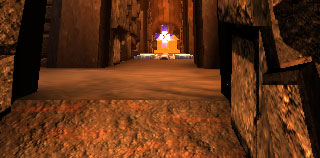
GeForce4 - 2X (16-tap) Anisotropic Filtering enabled
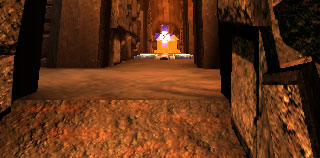
GeForce4 - 4X (32-tap) Anisotropic Filtering enabled
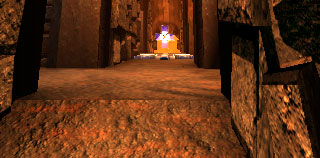
GeForce4 - 8X (64-tap) Anisotropic Filtering enabled
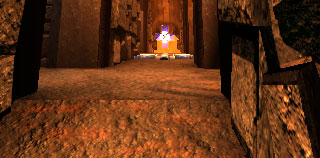
Radeon 9700 Pro - 16X Performance Anisotropic Filtering Enabled
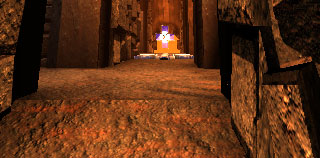
Radeon 9700 Pro - 16X Quality Anisotropic Filtering Enabled
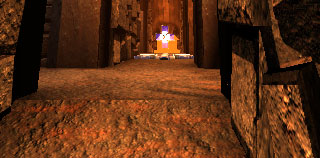
It's important to note that in most cases (such as the one above), you won't be able to tell any difference between ATI's performance and quality anisotropic filtering settings.
As you can see, ATI's 16X offers quality that rivals NVIDIA's 8X. But why compare the two? Remember that ATI uses an adaptive algorithm that doesn't always take the maximum number of samples dictated by the anisotropic filtering setting, this allows the Radeon 9700 Pro to offer similar image quality in many cases but with a much lower performance hit. Let's take a look at the numbers to see how low.
Anisotropic Filtering Performance
In order to measure anisotropic filtering performance we turn to UT2003 once again using the antalus benchmark:
|
Immediately you see the performance benefits of ATI's adaptive anisotropic filtering algorithm; granted, it doesn't always make things look perfect but the pros definitely outweigh the cons as you can see by the results above.
Antialiasing Quality
With the R300 ATI finally introduced a multisampling AA algorithm into their product line, let's see how it stacks up against the GeForce4's multisampling algorithm:
No Antialiasing
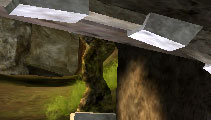
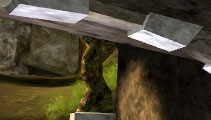 Radeon 9700 Pro 4X AA |
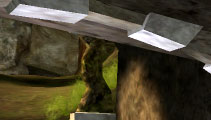 GeForce4 Ti 4600 4X AA |
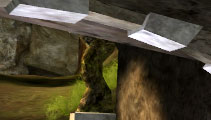 Radeon 9700 Pro 6X AA |
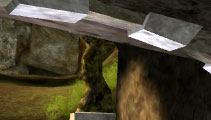 GeForce4 Ti 4600 4XS AA |
You'd be hard pressed to find any differences between the two cards when it comes to AA image quality; they both look equally good, especially at their comparable 4X settings.
Antialiasing Performance
We used the same benchmark we used in our anisotropic filtering tests, but this time around we're using it to measure AA performance.
|
You can see that the move to a multisampling AA algorithm helped ATI considerably, even their 6X AA mode is now effectively a useable option in a lot of games.
AA & Anisotropic Filtering Performance - Unreal Tournament 2003
What good is the Radeon 9700 Pro if it only excels at 1600x1200? For those of you with monitors that aren't capable of going that high, the Radeon 9700 Pro provides a different option. Instead of increasing the resolution, keep it set at 1024x768 but crank up some of the features. If you're spending $399 on a video card you should be able to run at 4X AA with 16X anisotropic filtering enabled, but will the Radeon 9700 Pro allow it and still attain reasonable frame rates?
We ran a subset of our benchmarks with the following settings for the Radeon 9700 Pro:
- 4X AA
- 16X Quality Anisotropic Filtering
The GeForce4 Ti 4600 was run with these settings enabled:
- 4X AA
- 4X Anisotropic Filtering (a good balance among the three options)
|
|
|
While not as playable at the higher resolutions, at 1024x768 with AA & anisotropic filtering cranked up, the Radeon 9700 Pro is definitely playable - even in this very stressful benchmark.
|
|
|
You'll remember dm-asbestos as the benchmark that the Ti 4600 came close to the Radeon 9700 Pro in, but not anymore. When AA and anisotropic filtering are enabled, the Ti 4600 falls behind considerably.
|
|
|
The trend continues with our final UT2003 test.
AA & Anisotropic Filtering Performance - Comanche 4
|
|
|
What once was a CPU limited benchmark is now stressing the limits of the Radeon 9700 Pro at 1024 x 768. At the higher resolutions, other limitations of the engine begin to come into play.
AA & Anisotropic Filtering Performance - Jedi Knight 2
|
|
|
Jedi Knight 2 is another formerly CPU bound benchmark that really opens up to the Radeon 9700 Pro once AA and anisotropic filtering are enabled.
AA & Anisotropic Filtering Performance - Serious Sam 2
|
|
|
We see a very similar trend under Serious Sam 2.
CPU Scaling
We conclude our benchmark investigation of ATI's Radeon 9700 Pro with our usual CPU scaling test. Here's a quick refresher about how we test CPU salability:
Our goal with these tests was to isolate CPU clock speed as the only variable, not cache sizes, not architectures, not FSB speeds, only clock speed. In order to achieve this we took an Athlon XP 2100+ and unlocked it so that we could adjust the clock multiplier. We kept the FSB set at 133MHz and adjusted the multiplier from 6.0x, yielding an 800MHz clock speed, up to the default 13x multiplier. Although this method produces some unofficial and unavailable processor/FSB/clock speed combinations, it serves our needs perfectly. So although a 800MHz Athlon XP processor running on a 133MHz FSB won’t be directly comparable to a genuine Athlon running at 800MHz, you’ll at least get an idea of what a CPU around that speed would give you, performance-wise.
In order to deal with the fact that the Radeon 9700 ends up being CPU bound at resolutions as high as 1024x768, we chose two resolutions to run the tests at - 1024x768 and 1280x1024.

Before the 933MHz mark, the Ti 4600 is actually faster than the Radeon 9700 Pro; slower PCs should definitely not be equipped with the Radeon 9700 Pro, you would not be getting your money's worth. It isn't really until you reach the 1.33 - 1.40GHz mark that the 9700 Pro really begins to pull away.

At higher resolutions, the difference between the cards is more pronounced thanks to the Radeon 9700 Pro's incredible memory bandwidth.
Final Words
It has definitely been a while since we've been able to say that an ATI card has lived up to its expectations, but the Radeon 9700 Pro does live up to every last one of our expectations. The question truly ends up being, does it meet your expectations?
There are three things that the Radeon 9700 Pro can offer at this point:
1) The highest performance in current and future games.
2) The ability to play at 1600x1200 in just about any game currently available or soon to be made available, and
3) The ability to play virtually any game at 1024x768 with 4X AA and 16X anisotropic filtering enabled at smooth frame rates.
The first point is moot because you should never buy a video card based on the performance it will offer in games that are no where near being released. While it is true that the Radeon 9700 Pro is probably the best card out right now for Doom III, there will be something faster and cheaper closer to the time Doom III is released. But if you're looking to play anything this fall (UT2003, etc...) then the 9700 Pro makes a lot of sense.
The last two points will really determine whether the Radeon 9700 Pro is the card for you; if either of those options appeal to you, then the Radeon 9700 Pro is probably very well suited for your needs.
We would recommend buying a Radeon 9700 Pro over a GeForce4 Ti 4600 if you're buying today, even taking into account the ~$100 price difference between the two cards. What we can't offer a recommendation on however, is what to do when the issue of NV30 comes into the picture. If NVIDIA is able to meet their schedules, NV30 will be out around December and at a price competitive with the Radeon 9700 Pro.
Waiting until later this Fall will also grant you the option of going with the Radeon 9500, a 4 pixel pipeline version of the Radeon 9700 running at lower clock speeds. Or if you're looking for a bit more, the All-in-Wonder Radeon 9xxx cards based on the R300 will be announced later this year as well. Paired with a new video encoder chip, the new All-in-Wonder card should prove to be the biggest hardware upgrade the AIW series has seen in years.
Regardless of what path you choose the Radeon 9700 Pro is a viable option from ATI, and it has been a very long time since we've been able to say that as well.

